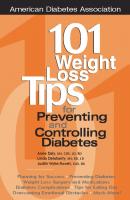101 Weight Loss Tips for Preventing and Controlling Diabetes. Anne Daly
Чтение книги онлайн.

Читать онлайн книгу 101 Weight Loss Tips for Preventing and Controlling Diabetes - Anne Daly страница 5
Название: 101 Weight Loss Tips for Preventing and Controlling Diabetes
Автор: Anne Daly
Издательство: Ingram
Жанр: Спорт, фитнес
Серия: 101 Tips Series
isbn: 9781580403948
isbn:
|
|
What is a “state-of-the-art” weight management program? |
TIP:
The best program is like the lifestyle-change one used to prevent diabetes in the Diabetes Prevention Program (DPP). Lifestyle-change patients had a daily goal for grams of total fat. If meeting that goal did not help them lose weight, they worked on eating 1,200–1,800 calories a day, with less than 25% of calories from fat. Patients were asked to do 30 minutes of moderate physical activity, such as brisk walking, at least 5 days a week. For support and education, they attended 16 individual sessions over 6 months and group sessions with 10–20 others. The lifestyle-change staff was a team of professionals, including RDs, exercise physiologists, and behaviorists. Participants kept daily records of calories and physical activity (minutes or calories burned). Most patients completed the 3-year study, reaching their lifestyle goals. The results were dramatic: 58% of those in the lifestyle-change group prevented diabetes, compared to 31% of those who just took medication. The state-of-the-art program gives you goals for daily fat grams, calorie range, physical activity, and record keeping, and provides you with professional support, in both individual and group sessions.
| Are food records really necessary—if so, why? |
|
TIP:
Yes. This is one of the best weight loss techniques. If you write down what you eat and drink, you are more likely to succeed at weight loss and weight maintenance. Food records give you the history of what you’ve eaten, so that your weight loss—or weight gain—is no mystery. Besides that, food records give you something real to work with. You can identify problems, and you can begin to problem-solve. Without records, you won’t even know what the problems are. Record keeping helps you monitor your progress and skill level, and identify patterns in your weight management behavior. The feedback from your records strengthens your skills for weight management. Write down foods within 15 minutes of eating. Most successful record keepers total their numbers at the end of the day or the first thing the next morning on a weekly summary sheet. Keeping good records is a skill that takes lots of practice to develop. There will be stops and starts, and most people do not enjoy keeping records, because they take work. But it is really worthwhile work. You will benefit from it!
|
|
What do food records look like, and what do I do with them? |
TIP:
You can keep your records in a spiral notebook or on cards or however you want to do it. Your records need columns or places to write the name of food, the serving size (ounces, cups, tablespoons), and the calories or fat grams or carbohydrate grams of servings or exchange groups, depending on which meal planning method you use. For weight management, you can track the number of servings of vegetables and fruits you eat per day—and aim for 5 or more (3 veggies, 2 fruits). At the end of a week, you can add up your weekly totals of calories, vegetable servings, fruit servings, etc. From those totals, you can figure your average daily calorie, carbohydrate, and fat intake. Make a column for anything else that has an impact on your food choices or eating behavior during the day. You should note the time you eat, where you are, whom you’re with, and if anything is causing tension around you. You should note your daily exercise—even if it’s just climbing the stairs, it all counts. If you take diabetes medication, you can list that, too. The food you eat interacts with the pills or insulin and with exercise, so put that in your record, too.
| What about very-low-calorie diets—are they recommended for people with diabetes? |
|
TIP:
Very-low-calorie diets (VLCDs), with less than 800 calories a day, have been used in the treatment of high-risk overweight patients and, in particular, people with type 2 diabetes. On this weight loss program, you drink at least 5 servings of a commercial formula product daily plus generous amounts of calorie-free beverages, and perhaps some СКАЧАТЬ